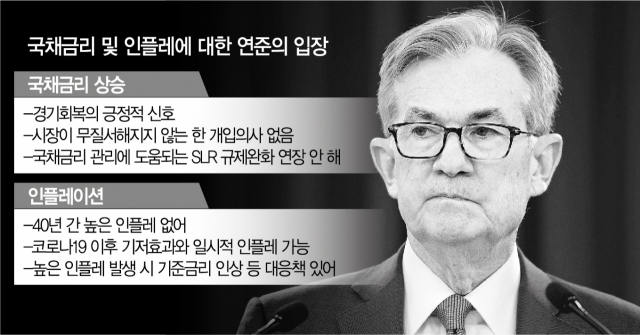Expected break and SLR mitigation measures ended
Low willingness to manage government bond yields
Although it responds by raising prices and interest rates
Concerns about falling growth rate and stock market confusion
“The stock price will be adjusted by 10%”
Powell 23-24 Congressional testimony attention
 viewer
viewer
Contrary to market prospects, the US Federal Reserve (Fed) decided to end bank capital deregulation as scheduled, making it clear that it is not willing to manage Treasury yields in the current situation. The Fed is in the position that if a rise in government bond yields leads to high inflation, it can respond by raising the benchmark interest rate, which raises concerns that a decline in growth rate and market turmoil may occur.
Wall Street officials are expressing disappointment when the Fed decided not to extend the bank’s complementary leverage ratio (SLR) easing measures, which will end at the end of this month, according to the Wall Street Journal (WSJ) on the 20th (local time).
SLR, introduced after the 2008 financial crisis, is a regulation that mandates banks with total assets of over $250 billion to maintain at least 3% of their equity capital. As market volatility increased with the spread of the new coronavirus infection (Corona 19) last year, banks and hedge funds sold large amounts of U.S. Treasury bonds to meet this regulation, causing interest rates to soar. Since then, it has temporarily eased regulations, but it will return to its original state at the end of this month. Industry has argued that if the regulation is revived, banks can sell off government bonds, resulting in higher returns.
Considering this, the end of the Fed’s SLR easing measures has a symbolic meaning. This is not an issue that has an absolute impact on Treasury bond yields, but extending the measure could show the market that the Fed is interested in managing returns. “It’s not a disaster, but it’s not an optimal situation,” said Krishna Guha, vice chairman of market analyst Evercore ISI. In fact, the 10-year Treasury bond yield, which once exceeded 1.75% a year on the 18th and then fell, again broke the 1.73% level on the 19th.
The reason the Fed is not afraid of rising government bond yields and inflation is because of its belief that there is a way to respond to high inflation. US economic broadcaster CNBC said, “Rising interest rates are the Fed’s most common way to control inflation, and tightening such as asset purchase adjustments is also a powerful weapon,” said CNBC. “These tools are costly and can be fatal to economic growth. He pointed out that in the early 1980s, there was a recession due to successive interest rate hikes.
Currently, the market is accepting the Fed’s recent moves, including the end of SLR easing measures, as a sign that the economic recovery is accelerating and tightening is nearing. Quincy Crosby, chief market strategist at Prudential Financial, said, “What if the economy improves faster than the Fed’s revised forecast?”
The volatility of the stock market is also expected to increase. Leo Grohowski, Bank of New York Mellon, Chief Investment Officer, Wells Management, predicted that “the stock market could be subject to a 10% correction due to inflation or soaring bond yields.”
For this reason, there is an expectation on Wall Street that the Fed will ultimately have to take further action on the government bond market. Ray Dalio, the founder of Bridgewater Associates, the world’s largest hedge fund, said, “The supply of government bonds is increasing due to the US government’s increased spending. The Fed will have to buy more bonds.” There is also a constant talk of an increase in the proportion of long-term bond purchases (operation twist).
However, there are opinions that the government bond market may stabilize within 2-3 weeks. This is because major pension funds and Japan could increase their purchases of US Treasury bonds due to higher yields. CNBC said, “Wall Street is paying attention to Fed Chair Jerome Powell’s hearing on Corona 19 support measures in the House of Representatives and Senate on the 23rd and 24th,” and emphasized that “the personal consumption expenditure (PCE) inflation figure to be released on the 26th is also important.
Meanwhile, Fed Chairman Powell sent a contribution to the WSJ on the 19th, saying, “The recovery has not been completed at all. The Fed will continue to provide the support the economy needs, no matter how long it takes.” In addition, he argued that “the government’s’all-in’ response is necessary to overcome the Corona 19 crisis.” It is interpreted that he expressed his thoughts again through a contributing article when market unrest did not subside even though he expressed his intention to maintain the easing financial policy.
/New York = Correspondent Kim Young-pil [email protected]
< 저작권자 ⓒ 서울경제, 무단 전재 및 재배포 금지 >
